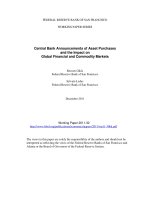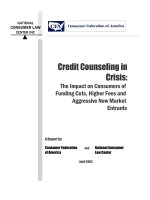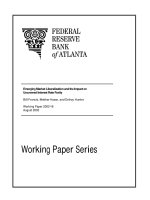Financial accounting the impact on decision makers 9e chapter 7
Bạn đang xem bản rút gọn của tài liệu. Xem và tải ngay bản đầy đủ của tài liệu tại đây (3.91 MB, 49 trang )
Chapter 7
Receivables and Investments
Accounts Receivable
Receivable arising from the sale of goods or services with a
verbal promise to pay
Stated on the balance sheet at net realizable, which takes into
account and estimate of the uncollectible amount (bad debts)
Two methods used in estimating bad debts:
Percentage
of sales approach
Percentage of receivables approach
LO 1
The Use of a Subsidiary Ledger
Assume that Apple sells $25,000 of hardware to a
school. The sale results in the recognition of an asset
and revenue
The Use of a Subsidiary Ledger
Contains the necessary detail on items that collectively make up
a single general ledger account, called the control account
Two Methods to Account for
Bad Debts
Direct write-off method: recognition of bad debts expense at
the point an account is written off as uncollectible
Allowance method: estimating bad debts on the basis of either
net credit sales or accounts receivable
Allowance
for doubtful accounts: a contra-asset
account—reduce accounts receivable to its net
realizable value
Example 7.1—Using the Direct WriteOff Method for Bad Debts
Assume that Roberts Corp. makes a $500 sale to Dexter Inc. on
November 10, 2014, with credit terms of 2/10, n/60
Example 7.1—Using the Direct WriteOff Method for Bad Debts (continued)
Assume further that Dexter is unable to pay within 60 days. After pursuing
the account for four months into 2015, the credit department of Roberts
informs the accounting department that it has given up on collecting the
$500 from Dexter and advises that the account be written off. To do so, the
accounting department makes an adjustment
Example 7.2—Using the Allowance
Method for Bad Debts
Assume that Roberts’ total sales during 2014 amount to $600,000 and that at
the end of the year, the outstanding accounts receivable total $250,000. Also,
assume that Roberts estimates that 1% of the sales of the period, or $6,000,
will prove to be uncollectible. Under the allowance method, Roberts makes
an adjustment at the end of 2014
Example 7.2—Using the Allowance
Method for Bad Debts (continued)
Balance sheet presentation of accounts receivable
Accounts receivable
Less: Allowance for doubtful accounts
Net accounts receivable
$250,000
(6,000)
$244,000
Dexter’s $500 account is written off on May 1, 2015
Approaches to the Allowance Method
of Accounting for Bad Debts
Percentage of Net Credit Sales Approach
Uses
the past relationship between bad debts and
net credit sales to predict bad debt amounts
Percentage of Accounts Receivable Approach
Estimate
bad debts by relating them to the balance
in the Accounts Receivable
Example 7.3—Using the Percentage of
Net Credit Sales Approach
Assume that the accounting records for Bosco Corp. reveal the
following:
Average percentage = 2% ($153,700/$7,560,000 = 0.02033)
Example 7.3—Using the Percentage of
Net Credit Sales Approach (continued)
Assume the company uses the 2% rate and that its net
credit sales during 2014 are $2,340,000, Bosco makes
an adjustment of 0.02 × $2,340,000
Example 7.4—Using the Percentage of
Accounts Receivable Approach
Assume that the records for Cougar Corp. reveal the following:
Average percentage = 0.8% ($32,330/$4,038,000 = 0.008)
Example 7.4—Using the Percentage of
Accounts Receivable Approach (continued)
Assume balances in Accounts Receivable and
Allowance for Doubtful Accounts on December 31,
2014 is $865,000 and $2,100, respectively
Example 7.4—Using the Percentage of
Accounts Receivable Approach (continued)
The
net realizable value of Accounts Receivable
is determined as follows:
Exhibit 7.1—Aging Schedule
Aging schedule: categorizes the various accounts according to their
length of time outstanding
Example 7.5—Using an Aging Schedule
to Estimate Bad Debts
The totals on the aging schedule are used as the basis for
estimating bad debts, as shown below
Example 7.5—Using an Aging Schedule
to Estimate Bad Debts (continued)
Assume that Allowance for Doubtful Accounts has a balance of
$1,230 before adjustment, the adjusting entry is as follows:
Accounts Receivable Turnover Ratio
Measures the number of times accounts receivable is collected
during the period
Net Credit Sales
Accounts Receivable
=
Turnover Ratio
Average Accounts Receivable
LO 2
Number of Days’ Sales in Receivables
Measures how long it takes to collect receivables
Number of Days in the Period
Number of Days’
=
Sales in Receivables
Accounts Receivable Turnover Ratio
The Ratio Analysis Model
1.
How many times a year does a company turn over its accounts
receivable?
2.
Gather the information about net credit sales and average
accounts receivable
3.
Calculate accounts receivable turnover ratio
4.
Compare the ratio with prior years and with competitors
5.
Interpret the ratios—measures how long it takes to collect
receivables
The Business Decision Model
1.
2.
3.
4.
5.
If you were a banker, would you loan money to a
company?
Gather information from the financial statements
and other sources
Compare the company's accounts receivable
turnover ratio with industry averages and look at
trends
Lend money or find an alternative use for the money
Monitor the loan periodically
Notes Receivable
Asset resulting from the acceptance of a promissory note from
another entity
Promissory note: a written promise to repay a definite sum of
money on demand or at a fixed or determinable date in the
future
Maker: party that agrees to repay the money
Payee: party that will receive the money
Note payable: a liability resulting from the signing of a
promissory note
LO 3
Summary of Relationship Between
Maker and Payee
Important Terms Connected with
Promissory Notes
Principal—the cash received, or the fair value of
the products or services received, by the maker
when a promissory note is issued
Maturity date—the due date of promissory note
Term—the length of time a note is outstanding
Maturity value—the amount to be paid by the
maker on the maturity date
Interest—the difference between the principal
amount and the maturity value









